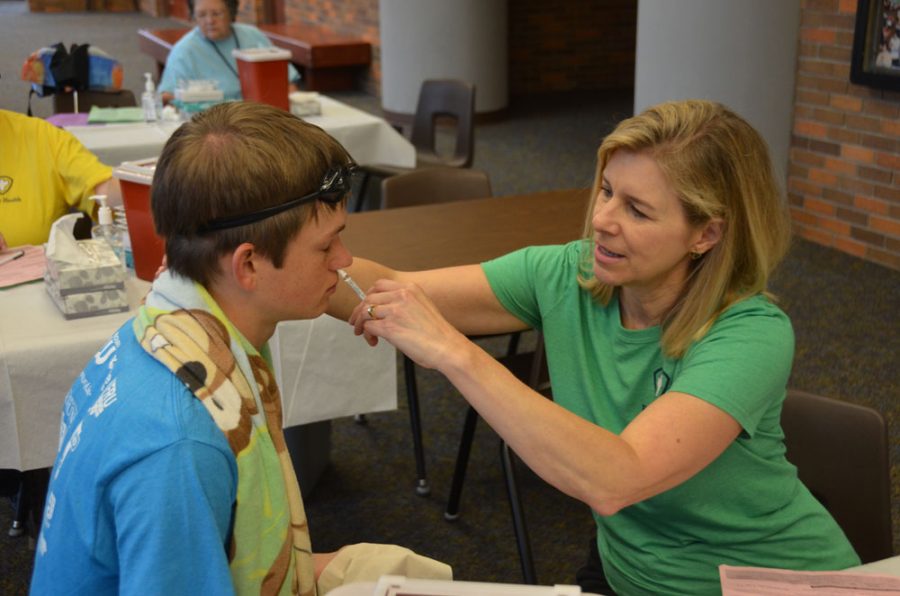Enteroviruses, like Ebola, have common similarities
EV-D68, and to a larger extent Ebola, has been the focus of the world’s media these last few months. is an infectious respiratory disease most common among younger children. There have been 1,112 laboratory confirmed cases of EV-D68 in 47 states with nine deaths attributed to the virus.
Enteroviruses are nothing new and surface annually, usually during the summer and late fall, said Dr. Michael Cooperstock, an infectious disease specialist in the University of Missouri Health Care System.
“Enteroviruses is a whole group of viruses. There are several hundred different ones, different strains,” Cooperstock said. “They come every year without fail, peaking almost always in August or September and then pretty much go away the rest of the time. By December they go away and we hardly see any enterovirus for the rest of the year.”
Even though there is a degree of certainty to when enteroviruses come, there is little certainty as to which enterovirus is present during a given year.
“Enterovirus D68 is just one of many, many different enteroviruses, and this happened to be its time to come and be ascendant,” Cooperstock said. “Nobody knows why they shift from one to the other, or what makes one more prevalent.”
EV-D68 has managed to set itself apart from other enteroviruses in Cooperstock’s eyes.
“It was a little angrier than the rest,” Cooperstock said. “The fact that it’s been so widespread and caused so many kids to be hospitalized is different. Every year we get a few kids that are in the hospital with one or the other enterovirus but rarely this many of them. It may or may not be more contagious, meaning it may affect more people, or just more virulent, meaning when it does infect a person it makes them sicker. I think it’s probably the latter.”
Mild symptoms of EV-D68 include fever, runny nose, sneezing, cough, and body and muscle aches with more severe symptoms including difficulty breathing and wheezing. EV-D68 is especially dangerous for those who have asthma or a history of respiratory illness. For junior Jodie Bappe she initially thought she had the flu.
“At first I just thought it was a cold because I was congested and I had a cough, but it progressively got worse over the course of just a couple days,” Bappe said. “Eventually I was finding it really, really difficult to breathe and I couldn’t take any deep breaths in.”
For Bappe her situation rapidly deteriorated, so much so that she had to visit an urgent care facility.
“They put me in a room so that they could take an x-ray to make sure I didn’t have pneumonia,” Bappe said. “They ended up just giving me an inhaler and a breathing treatment and then sent me home.”
There is currently no treatment or cure for EV-D68. This limits doctors to prescribing only supportive therapy.
“The rest is treating the asthma part of it like you would treat anybody else with asthma,” Cooperstock said. “[Make] sure the person you know is well hydrated so they don’t get dehydrated. If they’re in the hospital then sometimes they need IV’s. If they’re wheezing, then sometimes they need medicine for if they get it a secondary infection, which didn’t happen too often. You can give antibiotics for the bacteria that caused the secondary infection.”
To prevent spreading or catching EV-D68 Cooperstock recommends normal hygiene.
“If you’re sick, stay home,” Cooperstock said. “If you already have asthma and you want to avoid it, stay away from crowds and stay away from people who are sick. If you have relatives coming to visit, you don’t want to get too close to the ones who have any type of a respiratory illness, cold, cough, [or] anything like that. Do hand hygiene, meaning wash your hands before you eat, after you eat [and] after handling another person physically; just normal healthy cleanliness which you want to do to prevent many, many, many different infections. If you cough, cough into your arm, not into your hands because then you spread it around on your hands.”
For RBHS students, the risk of catching EV-D68 is relatively low. According to Cooperstock it is mainly an illness for young children and school aged kids.
This does leave the young children of teachers at risk, as well as the younger siblings of high school students.For RBHS science teacher Stephanie Harman, EV-D68 was something she kept in mind when dealing with the health of her 19-month-old daughter.
“If you look at enterovirus as a group, how much death they caused, you would probably find that there are some deaths every year from enterovirus, probably fewer than this one because it is more aggressive.”—Stephanie Harmon, chemistry teacher
Although EV-D68 is a serious disease, Cooperstock believes the media has blown the virus out of proportion.
“It’s happening now with this Ebola story and it’s happened over and over again with all sorts of infectious illnesses that come along. It’s so easy for the media to tell the very worst part of the story and then even if the small print tries to put it in perspective, the public gets this message that there is something horrible happening out of proportion to what is really happening,” Cooperstock said. “The way things comes across to the public and the media are often very different from the way we see them from the inside of the medical profession. If you really looked carefully at any enterovirus season there would be a few deaths. If you look at enterovirus as a group, how much death they caused, you would probably find that there are some deaths every year from enterovirus, probably fewer than this one because it is more aggressive.”
For those worried about enterovirus, Cooperstock, estimates that a person is far more likely to be killed in an automobile accident or by the flu than by an enterovirus.
“At the same time, every year in the United States 20,000 people die of influenza — the flu — [which is] way more, way more, virulent than this virus is and that’s not newsworthy because it isn’t new. It’s year in and year out and yet in terms of the way the public should be understanding these infectious diseases. They ought to be getting their flu shot if they’re worried about enterovirus D68.”
By Graham Ratermann
Opting for a flu mist, junior Clayton Warder received his flu vaccine on Tuesday, Oct. 14. In a proactive approach to combat the flu season, students were offered a flu vaccine either in the form of a shot or a mist with no charge to the student. Photo by Levi Smith.


























































































